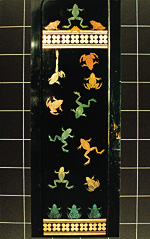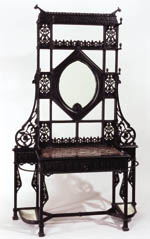Culture Watch
Shock of the Old:
Christopher Dresser
First comprehensive museum retrospective of the works of 19th-century
British industrial designer on view at the Smithsonian’s
Cooper-Hewitt,
National Design Museum
(March 5 - July 25, 2004)
This entire exhibit at New York City's Cooper-Hewitt is
a shock to the system. A dazzling array of domestic design objects — textiles,
wallpapers, furnishings, carpets, glass, ceramics and metalware — have
been assembled to educate laymen about the genius of this little-known
Scottish commercial designer, regarded by many as the world’s
first professional industrial designer.
Unlike the great 19th-century English designer William
Morris, Christopher
Dresser embraced the Industrial Revolution and reveled in the possibilities
of mass-production, designing affordable items for a middle class hungering
for high-quality items incorporating, as the exhibit explains, “their
Victorian passion for novelties, their love of the grotesque and medieval,
and their craving for Japanese patterns.”
Morris was part of the Arts
and Crafts movement, which yearned for a return to the days of the
medieval guilds. He encouraged  handcraftsmanship, but the results were pricey,
limiting
the audience. Dresser was a believer in the new technologies. His designs
were machine-made and targeted a wider circle. His knowledge of the latest
factory
processes, coupled with an understanding of his audience, “made him the
ideal partner to industry,” we are told.
handcraftsmanship, but the results were pricey,
limiting
the audience. Dresser was a believer in the new technologies. His designs
were machine-made and targeted a wider circle. His knowledge of the latest
factory
processes, coupled with an understanding of his audience, “made him the
ideal partner to industry,” we are told.
Shock of the Old: Christopher Dresser marks the centennial of the designer’s death in 1904. The show, housed on two floors of Andrew Carnegie’s oak-paneled mansion, is comprised of more than 300 objects designed by Dresser and produced by more than 50 manufacturers, the likes of Minton, Wedgwood and Coalbrookdale, to name a few. He studied botany in addition to design, and we see the influence in his design patterns, which “take motifs from nature and work them into abstractions,” Geraldine Erman, a museum teacher at Cooper-Hewitt, explained on a recent tour of the exhibit. Add the curators, “Rejecting the naturalism of Victorian ornament, Dresser advocated stylization in design.”
His intense interest in ornament and pattern owes considerable debt to his mentor Owen Jones, compiler of the 1856 tome, The Grammar of Ornament. He dipped into a wide range of cultural pots — Peruvian, Islamic, Abyssinian, and Far Eastern — but a three-month sojourn to Japan in 1876-1877 left a lasting impression, transforming the self-styled ornamentalist into a designer of simple, no-frills, utilitarian forms derived from Shinto art.
Case in point: The second-floor exhibit-displays of sleek, silver-plated
metal tea sets, toast racks, and decanters, “shocking” harbingers
of modernism in their devotion to function and avoidance of  ornamentation.
The
emphasis is on geometric forms derived from Japanese metalwork and Chinese
Yixing stoneware teapots. The teapots that he designed for James Dixon & Sons
in 1879-1880 presage the metalwork of Bauhaus designers Marianne Brandt
and Wolfgang Tumpel.
ornamentation.
The
emphasis is on geometric forms derived from Japanese metalwork and Chinese
Yixing stoneware teapots. The teapots that he designed for James Dixon & Sons
in 1879-1880 presage the metalwork of Bauhaus designers Marianne Brandt
and Wolfgang Tumpel.
My personal favorite in the silver-plated metal series: the 1885 conical sugar bowl, perched on three grasshopper legs, which was produced by Elkington & Co. in Birmingham. (For serious collectors and those with deep pockets, Conical Sugar Bowl no. 1 of 99 in sterling silver is available at the Shop at Cooper-Hewitt for $5,900, courtesy of Alessi and silversmith Brian Asquith; non-connoisseurs should not feel left out — there’s a fun, thermoplastic resin version in green for only $30!)
The Teak Room is an offshoot of this main-hall gallery and offers a spectacular collection of glazed pottery, which Dresser designed for Linthorpe Art Pottery in Middlesbrough, England, from 1879-1882. The shapes of these brilliantly colored vases, vessels, pitchers and jugs are quite innovative and derive from Japanese, Moroccan and Peruvian ceramics.
Ms. Erman marveled on her tour that “We can see the Japanese influence in the flow of the glaze,” not to mention one particularly beautiful gourd-shaped vase. A Peruvian stirrup-spout vessel sits between two remarkably similar containers designed by Dresser, making the obvious point.
The Scotsman’s vocabulary has its roots in design history and the
Japanese aesthetic, but was also, as the show points out, influenced by
the language
of his contemporaries like English illustrator Aubrey Beardsley and English
architect and decorator Charles F. A. Voysey. Dresser’s impact is
 assessed by Cooper-Hewitt Director Paul Warwick Thompson, who notes, “To
our contemporary eyes, Dresser is undoubtedly the most interesting of late
19th-century designers — and
the one whose work bears the most relevance to our present-day concerns
with production, form, materials and eclecticism.”
assessed by Cooper-Hewitt Director Paul Warwick Thompson, who notes, “To
our contemporary eyes, Dresser is undoubtedly the most interesting of late
19th-century designers — and
the one whose work bears the most relevance to our present-day concerns
with production, form, materials and eclecticism.”
Designer Terence Conran speaks to the legacy issue, saying Dresser, “has always been inspirational to me. He was strongly committed to industrial production and was a breath of very fresh air in a Victorian world filled with gross, vulgar, over-decorated, pretentious design. It’s wonderful, a hundred years from his death, that he is getting the recognition that is so long overdue.”
Viewers take note: Don’t miss the giant, ebonized wardrobe (c.1879) on the first floor, which Dresser designed for Bushloe House in Leicester, home to his solicitor Hiram B. Owston. The door panels are festooned with leaping frogs and are a joy to behold; a side panel reveals a stray amphibian dangling perilously from a rope. We see here Dresser’s fondness for whimsy, but also, as the catalogue states, his “love for grotesque imagery.” And, oh yes, speaking of grotesque imagery, there’s the red-and-green wallpaper in an adjacent hallway riddled with gargoyle-like figures and knotting that evokes Celtic designs.
See it.
The Shock of the Old travels next to the Victoria & Albert
Museum in
London, where it will be on display from September 9 to December 5,
2004.






